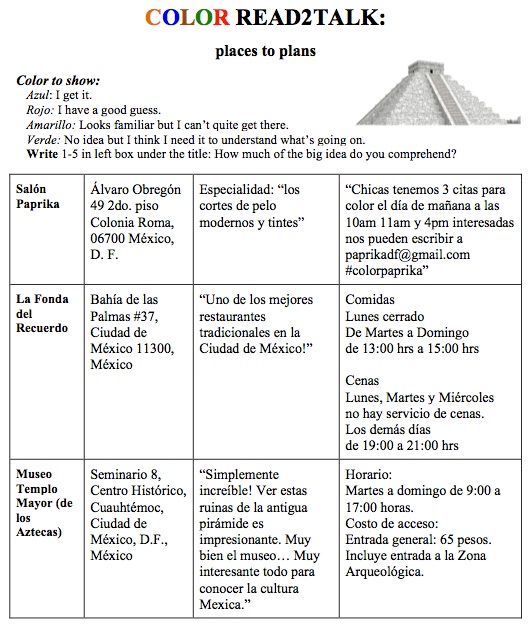 Have you seen the movie Canela? This semester I’ve been so grateful that Kara Jacobs and Elena López introduced me – FINALLY – to an authentic Mexican family film that’s appropriate for any classroom and any student anywhere (a rare find in Spanish-language cinema available in the U.S., as I’m sure you know). So grateful, in fact, that the movie has framed our entire semester as I’ve taken the opportunity to mine the film for authentic language and culture that has actually become our curriculum. I mean MINE like in the depths of the earth’s core: in fourteen 90-minute classes together we have made it through an astounding 21 minutes of the film.
Have you seen the movie Canela? This semester I’ve been so grateful that Kara Jacobs and Elena López introduced me – FINALLY – to an authentic Mexican family film that’s appropriate for any classroom and any student anywhere (a rare find in Spanish-language cinema available in the U.S., as I’m sure you know). So grateful, in fact, that the movie has framed our entire semester as I’ve taken the opportunity to mine the film for authentic language and culture that has actually become our curriculum. I mean MINE like in the depths of the earth’s core: in fourteen 90-minute classes together we have made it through an astounding 21 minutes of the film.
You see, my students are Novice Mid at most and aren’t ready to sit through an authentic film and experience the comprehensible input they need in order to improve their proficiency. They need some serious scaffolding. In that process, I typically develop a 4-to-6-page guide to a segment of the film from one to three minutes long. You can see how I’ve been adapting Kara and Elena’s resource for early novices here. It’s a bit of a messy work in progress but it’ll give you an idea, and if you like, you can take it and make it your own.
Between aural input and oral output: Color Read2Talk

In the process of working through the film with my students, making it comprehensible, mining it for that authentic language and culture they can start using, I have thought and worked long on a variety of ways to interact with both. I’m calling this most recent strategy Color Read2Talk. It is a bridge between the aural input and the oral output, a middle piece in that continuum where on one end they’re passively listening to comprehensible input and on the other end they’re accomplishing a performance task in the target language. Here are the details on this particular piece:
- Target: I can make plans with someone to go somewhere.
- Previous knowledge: Activity words, place words, “I’m going to…”, time and day references
- Vocabulary: Parts of the city
- Structures:
A: Voy a (activity) el (day) a las (hour). ¿Me acompañas?
B: Claro / obvio.
- Step 1 CI: story in which Jeffrey the Penguin wants to go somewhere (downtown, in a neighborhood, in a suburb) with (X student) at such time on such day but the student doesn’t like to do the things until the third activity. (Side note: this previews our next target: “he/she likes to…”.)
- Canela clip: In the beauty salon, Jocelyn asks her best friend Regina to accompany her to a restaurant on Friday.
Now I know that I want students to use Jocelyn and Regina’s exact phrases (mining for authentic language!) to make plans, but what to do in between? How can I expose them to more language and culture and at the same time gauge their comprehension and readiness for our performance objective? Enter Color Read2Write. I found three places in D.F. and mined their websites and/or online review sites for authentic language referring to 1) where they are, 2) what they are / what they are like, and 3) their hours. I copied these into a grid, and I unapologetically “changed” the text by removing irrelevant pieces and copying what I wanted students to focus on. (I did not actually change any words. Maybe a capital letter.) Then, I ask students to use different colors and no reference materials to show me what they get:
- Blue: I get this part 100%.
- Red: I have a good guess about this.
- Yellow: This looks familiar but I can’t quite get this.
- Green: I have no idea, but I think I really need to understand this part in order to get the main idea.
Then, in the box on the left with the name of the place, I ask for students to tell me on a scale from 1 to 5 how much they comprehend. (They are used to this because we do a “fist-to-five” comprehension check on every presentation slide for Canela.)
Without further ado, I offer you the first Color Read2Write activity in Spanish: “Places to Plans: D.F.” I did not include our speaking target so that you could use it as a bridge to anything that fits your class. I hope you find it helpful.
Where can I get more?
For starters, subscribe to the blog in the top right to get posts like this delivered to your email, and check out my Resources page. Also, subscribe to my TeachersPayTeachers store.

Here’s an outro: The work I’ve done on Canela will hopefully be an ebook guide available for purchase by the end of the summer and will provide curriculum for Novice Mid students for up to an entire semester. If you’d like to be notified in email when this is available, let me know through the contact form.
I hope to present what I’ve learned in this process at the Central States Conference in Chicago next year and the annual conference of the Kentucky World Language Association. One session is titled “Mining for Gold: Leveraging Authentic Film for Real Language and Culture.” I hope to also present “Mining for [Elementary] Gold” about a similar process I’ve gone through to use a particularly novice-content episode of Peppa Pig for my younger students.
If the Dallas/Fort Worth area is doable for you this July, and you’d like to explore ideas like this to make your own set of tailor-made comprehensible input strategies that fit you and your classroom, be a #BraveLittleTailor with us. Everyone at the Brave Little Tailor workshop will receive a free copy of the Canela guide (when it is available).
Also, don’t forget that strategies like this will make up a big part of the third day of my three-day curriculum planning workshop, Camp Musicuentos, in Louisville and Chapel Hill this summer, as well as part of our one-day Camp Musicuentos overview in Rhode Island.
2 Comments
Comments are closed.




[…] students “made plans” with each other to go to the one of their choice in the activity Color Read2Talk. And as usual, one of the last things we did with the scene was a listening cloze. One of the […]
[…] … until Kara Jacobs and Elena López inspired me to use Canela with my older kids, which in turn inspired me to use a Peppa Pig episode with my younger kids. It […]